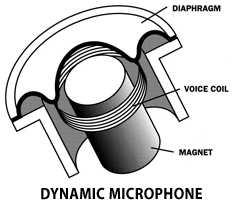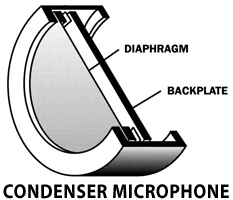There are so many microphones to choose from and, quite frankly, it can be hard to know which one is best for a particular application. Someone once said, "Knowledge is power" and that is what this little article is going to do - give you power through knowledge. We are going to equip you with the basic basics about how mics work and if I do my job correctly, well, like Chef Francois Minot says, "Anybody can make you enjoy the first bite of a dish, but only a real chef can make you enjoy the last." Go on; let your curiosity get the best of you. Read the rest of the article.
Choosing the right microphone is kind of like choosing what you want to eat. Sometimes you base your meals around what you desire in the moment and other times you pick food because it's what your body needs. Also, with every meal you eat comes ingredients that were used to make up that meal. Now, if I can get you to suspend reality for a moment and think of microphones in this same manner we will be able to remove a lot of the mystery surrounding mics and how they are to be used. In order to help you choose the right mic I'm going to talk a little bit about the ingredients, the stuff that mics are made of and since I'm already talking about food, let's start there.
Food for Thought
Way, way back in November (that would be last month) I was in Chicago for another
Seminars4Worship event. While I was there I had all these food ideas swimming through my mind. Before I left I had to make sure to get some authentic Chicago-style pizza and a genuine Chicago hot dog (after all, Chicago is the home of Vienna Beef). So, have I used the word Chicago enough? I'm digressing, let me move on. One day during the Seminars4Worship event we had pizza brought in and boy was I excited. Unfortunately, when I started eating my expectations were dashed. The pizza wasn't that great but after asking around I found a place that fit the bill. My pizza craving was satisfied. For me, it all came down to the ingredients and how the pizza was made.
After reading about food for the last several paragraphs you may be getting hungry. Here's what you need to do. Go eat something! Otherwise you won't pay attention to the rest of this article, you won't learn what you need to, and my feelings will get hurt. So go eat.
Now that we got that out of the way, let's talk about microphone basics. One of the most often asked questions during our participation in the Seminars4Worship events was, "What's the difference between microphone models?" I would always try to answer simply and to the point but the question does beg for a semi-technical response. As I lay down a few basics here I will try to be as non-technical as possible. If your eyes start glazing over, I'll make sure to simplify.
Back to Basics
All microphones are transducers which is a fancy way of saying they turn acoustical energy (your voice or an instrument that is being mic'd) into electrical energy (the kind of energy your sound system can work with). There are many different models of microphones out there to choose from but there are only two main types of microphones that you will encounter on a regular basis. Before any of you purists get mad, let me say one thing: there are more than two types of microphones, but we will only be discussing the two types that most people use.
The two most common types of mics are dynamic and condenser. Dynamic mics use a diaphragm/voice-coil/magnet assembly and condenser mics are designed around an electrically charged diaphragm/backplate assembly.

Here's what that means to you:
With the dynamic mic, sound strikes the diaphragm (a thin plastic membrane) which vibrates in response to the sound hitting it. For a visual on this, lightly hold a piece of writing paper and talk into it. You will see how the air of your voice moves the paper. Attached to the diaphragm is a small coil of wire (think small slinky), called the voice coil, which moves or vibrates when the diaphragm moves. The combination of the voice coil and the magnet (see diagram at right) creates a magnetic field. When the voice coil moves, the magnetic field turns our acoustic energy into an electrical signal.
OK, I see eyes starting to glaze so I will make this a little more practical. Here's the skinny on dynamic mics: they are very rugged, like the
Shure SM58 (drop them 100' and they will still work), now with products like the new
AT 5 MIC Pack you can buy decent sounding mics for a resonable price. They can also handle greater sound pressure levels without distorting. On the other hand, they tend to have limited frequency response, especially in the high end. The frequency response of a mic will tell you how well that mic will reproduce all the sounds of the audio spectrum. Dynamic mics can't be made very small (usually the size of a hand or bigger) and they aren't very sensitive. Microphone sensitivity will determine how loud the signal coming out of the mic is based on how loud the signal going into it is. Dynamic mics usually need a little more input (volume of sound coming from your mouth or other source signal) in order to produce adequate output (volume that you can use at your sound board).

Condenser mics are a little more complicated in their design. I am going to over simplify so please don't throw stones at me if I am not being technical enough for you. Basically, sound waves hit the very thin metal diaphragm. As the diaphragm moves it changes the spacing between it and the backplate (see diagram at right) which is how an electrical signal is generated from your acoustic signal. In order for condenser mics to work they have special electronics built into them and those special electronics always need a power source. Condenser mics can be powered by batteries or by something called Phantom Power which can usually be found on your mixer.
There's the tech-lite version of how condenser mics work. Here are the pros and cons of condenser mics in no particular order. Poorly designed condensers will be noisy due to the special electronics in them and they will distort more easily at higher volumes. As a general rule (though it's more of a guideline then a rule) condensers are more expensive like the Shure KSM9 because of all the extra stuff it takes to make them. They are more sensitive than dynamic mics and usually have a better frequency response. The new Audio Technica (AT2010) is a perfect example of how articulated and sensitive a handheld condenser can be. If you have any really small mics around (Countryman E6i) they are probably condensers. These mics can be made so small that your eye can barely see them.
So why choose a dynamic over a condenser? Good question. I'm glad you asked. If you have a singer that really belts it out and loves to eat the mic (not literally) you might put them on a dynamic, like the Sennheiser E835. If you have a very dynamic singer (lots of quiet and loud transitions) a more sensitive condenser might be better for them such as the Shure Beta87. The sound source is important in determining what mic to use but your environment also has a part to play in the matter. Your environmental guideline is this: use a dynamic in unpredictable environments and use a condenser in a more controlled space.
That's all I have to say about microphone basics. There is definitely more I can write about the basics of mics but let's just baby step it for now.
By the way, I never did get my Chicago hot dog. So, if you feel the need to bless someone, you could fly me out to Chicago and treat me to a Chicago dog.

Microphone Basics
Richard Aronson is a seasoned musician and an audio / video producer. He serves as the Tech Director at Oakridge Ministries in Rainier Washington.